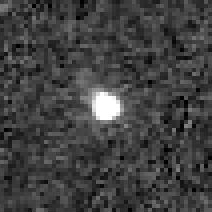
Summary
(40314) 1999 KR16 is a trans-Neptunian object on an eccentric orbit in the outermost region of the Solar System, approximately 254 kilometers (158 miles) in diameter. It was discovered on 16 May 1999, by French astronomer Audrey Delsanti and Oliver Hainaut at ESO's La Silla Observatory in northern Chile.[1] The very reddish object is a dwarf planet candidate and has a rotation period of 11.7 hours.[6][12]
 Hubble Space Telescope image of 1999 KR16 taken in 2010 | |
| Discovery[1] | |
|---|---|
| Discovered by | A. Dalsanti O. R. Hainaut |
| Discovery site | La Silla Obs. |
| Discovery date | 16 May 1999 |
| Designations | |
| (40314) 1999 KR16 | |
| 1999 KR16 | |
| TNO[2] · other[3] · distant[1] | |
| Orbital characteristics[2] | |
| Epoch 23 March 2018 (JD 2458200.5) | |
| Uncertainty parameter 2 | |
| Observation arc | 16.09 yr (5,878 d) |
| Aphelion | 64.604 AU |
| Perihelion | 33.968 AU |
| 49.286 AU | |
| Eccentricity | 0.3108 |
| 346.02 yr (126,383 d) | |
| 347.77° | |
| 0° 0m 10.08s / day | |
| Inclination | 24.771° |
| 205.57° | |
| ≈ 26 February 2030[4] | |
| 58.419° | |
| Physical characteristics | |
Mean diameter | 254±37 km[5] 255 km (est.)[6] |
| 5.8 h (half period?)[7] 11.7 h[8] | |
| 0.204±0.070[5] | |
| RR (very red)[9] | |
| 5.5[1][2] 5.527±0.039 (R)[10] 5.7[2] 5.59±0.02 (R)[11] | |
Orbit and classification edit
The minor planet orbits the Sun at a distance of 34–65 AU once every 346 years (126,383 days; semi-major axis of 49.29 AU). Its orbit has an eccentricity of 0.31 and an inclination of 25° with respect to the ecliptic.[2]
Numbering and naming edit
This minor planet was numbered by the Minor Planet Center on 26 May 2002.[13] As of 2019, it has not been named.[1]
Physical characteristics edit
1999 KR16 has two solutions of its rotation period of 6 and 12 hours, respectively,[7][8] and an albedo of 0.20.[5]
References edit
- ^ a b c d e "40314 (1999 KR16)". Minor Planet Center. Retrieved 11 September 2018.
- ^ a b c d e "JPL Small-Body Database Browser: 40314 (1999 KR16)" (2015-06-19 last obs.). Jet Propulsion Laboratory. Retrieved 11 September 2018.
- ^ Johnston, Wm. Robert (7 October 2018). "List of Known Trans-Neptunian Objects". Johnston's Archive. Retrieved 3 December 2018.
- ^ JPL Horizons Observer Location: @sun (Perihelion occurs when deldot changes from negative to positive. Uncertainty in time of perihelion is 3-sigma.)
- ^ a b c Santos-Sanz, P.; Lellouch, E.; Fornasier, S.; Kiss, C.; Pal, A.; Müller, T. G.; Vilenius, E.; et al. (May 2012). ""TNOs are Cool": A survey of the trans-Neptunian region. IV. Size/albedo characterization of 15 scattered disk and detached objects observed with Herschel-PACS". Astronomy & Astrophysics. 541: 18. arXiv:1202.1481. Bibcode:2012A&A...541A..92S. doi:10.1051/0004-6361/201118541. S2CID 118600525. Retrieved 2 December 2015.
- ^ a b Brown, Michael E. "How many dwarf planets are there in the outer solar system?". California Institute of Technology. Retrieved 3 December 2018.
- ^ a b Thirouin, A.; Ortiz, J. L.; Campo Bagatin, A.; Pravec, P.; Morales, N.; Hainaut, O.; Duffard, R. (August 2012). "Short-term variability of 10 trans-Neptunian objects". Monthly Notices of the Royal Astronomical Society. 424 (4): 3156–3177. arXiv:1207.2044. Bibcode:2012MNRAS.424.3156T. doi:10.1111/j.1365-2966.2012.21477.x. S2CID 53467482. Retrieved 2 December 2015.
- ^ a b Sheppard, Scott S.; Jewitt, David C. (September 2002). "Time-resolved Photometry of Kuiper Belt Objects: Rotations, Shapes, and Phase Functions". The Astronomical Journal. 124 (3): 1757–1775. arXiv:astro-ph/0205392. Bibcode:2002AJ....124.1757S. doi:10.1086/341954. S2CID 55644670. Retrieved 2 December 2015.
- ^ Belskaya, Irina N.; Barucci, Maria A.; Fulchignoni, Marcello; Dovgopol, Anatolij N. (April 2015). "Updated taxonomy of trans-neptunian objects and centaurs: Influence of albedo". Icarus. 250: 482–491. Bibcode:2015Icar..250..482B. doi:10.1016/j.icarus.2014.12.004. Retrieved 14 December 2016.
- ^ Peixinho, N.; Delsanti, A.; Guilbert-Lepoutre, A.; Gafeira, R.; Lacerda, P. (October 2012). "The bimodal colors of Centaurs and small Kuiper belt objects". Astronomy and Astrophysics. 546: 12. arXiv:1206.3153. Bibcode:2012A&A...546A..86P. doi:10.1051/0004-6361/201219057. S2CID 55876118. Retrieved 14 December 2016.
- ^ Jewitt, David; Peixinho, Nuno; Hsieh, Henry H. (November 2007). "U-Band Photometry of Kuiper Belt Objects". The Astronomical Journal. 134 (5): 2046–2053. Bibcode:2007AJ....134.2046J. doi:10.1086/522787. Retrieved 14 December 2016.
- ^ "LCDB Data for (40314)". Asteroid Lightcurve Database (LCDB). Retrieved 14 December 2016.
- ^ "MPC/MPO/MPS Archive". Minor Planet Center. Retrieved 24 February 2018.
External links edit
- "TNOs are Cool": A Survey of the Transneptunian Region IV - Size/albedo characterization of 15 scattered disk and detached objects observed with Herschel Space Observatory-PACS
- List of Transneptunian Objects, Minor Planet Center
- Asteroid Lightcurve Database (LCDB), query form (info Archived 16 December 2017 at the Wayback Machine)
- (40314) 1999 KR16 at AstDyS-2, Asteroids—Dynamic Site
- Ephemeris · Observation prediction · Orbital info · Proper elements · Observational info
- (40314) 1999 KR16 at the JPL Small-Body Database


